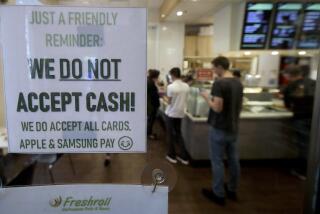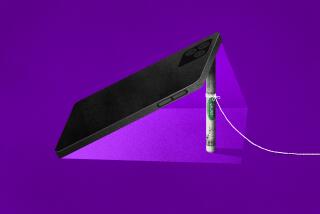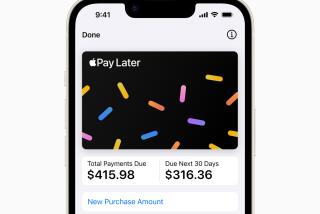Mobile payment systems are ringing up more competition
Forget ka-ching. Its all tap-tap these days.
Restaurants and shop owners fed up with antiquated cash registers and expensive credit card terminals are switching to cheaper devices that plug into smartphones and tablets. And companies such as PayPal, Square Inc. and Groupon Inc. are rushing to meet them, developing sleeker stands to mount tablets running their software or hooking up with existing systems.
The shift is happening as mobile devices permeate many facets of consumers’ lives, including the way they shop and pay for everyday items.
There are players of all sizes in the burgeoning mobile payment systems industry, including big U.S. financial institutions such as Bank of America and small start-ups such as Square in San Francisco. It has become a crowded field, and some of the bigger players are expanding their products to set themselves apart.
“It was a very simple solution, which makes it very difficult to develop differences,” said David Kaminsky, senior analyst for emerging technologies at Mercator Advisory Group. “Now you see them trying to expand into these slightly more complex tablet systems.”
The standard bearer has been Square, among the first companies to enable credit card payments to be accepted on mobile phones through its Square Reader and app in 2010. It has since seen a big boom in the number of businesses and people using their app, and it is now processing more than $15 billion in payments annually.
The company said it plans next month to release what it calls Square Stand, which incorporates a built-in card reader that attaches to an iPad and a USB hub that connects to accessories such as a cash drawer, receipt printer and scanner.
For the cost of an iPad and $299 for the Square Stand, the company says small retailers can get a cash register that organizes their inventory and provides instant sales analysis.
That’s significantly lower than similar systems running on standard cash registers that can be cumbersome and cost thousands of dollars.
“We’re seeing larger brick-and-mortar merchants increasingly tearing out their old point-of-sale systems to run their businesses with Square,” said Faryl Ury, Square spokeswoman. “We built the Square Stand for these businesses.”
She said use of Square continues to grow on smartphones, but it’s growing at a faster rate on iPads. IPad customers now account for nearly 50% of total payments processed by Square, and the average payment volume processed by iPad customers is more than double that of customers using smartphones.
Analysts expect a dogfight as PayPal takes on Square, launching in the next few weeks an incentive program aimed at persuading businesses to dump their tills.
PayPal, the pioneer of online payment services that is owned by retail giant EBay Inc., won’t be unveiling its own stand, but it will be launching a program called Cash for Registers.
PayPal is expected to announce Thursday that it will waive transaction fees for as much as $20,000 worth of transactions through January 2014 for the first 10,000 businesses that sign up beginning July 10.
Businesses that buy at least $450 in hardware -- such as a stand, printer or cash drawer -- can process payments through PayPal Here, the company’s card reader for smartphones, on the iPad. They can also take cards or PayPal payments on other checkout stand systems that run PayPal software, such as Vend and Shopkeep POS.
PayPal Here was initially geared more toward mobile payments than storefront purchases, said Carolyn Groobey, vice president of business products. In March, PayPal launched an app for the iPad, which can be bundled with stands that connect to a cash drawer and receipt printer.
“With the iPad app we’re now able to target more storefronts,” Groobey said. “The iPad app has a number of features that bring it closer to a point-of-sale system rather than what we offer on a phone.”
The company’s mobile payment transactions are rapidly growing. Last year PayPal handled nearly $14 billion in payments on mobile devices, up from about $4 billion in 2011, according to company filings.
Groupon also joined the fray, expanding its Breadcrumb POS program, which became available to all businesses in mid-May. The company previously offered its iPad-based cash register only to restaurants and bars.
Tablet-based cash registers are years, possibly decades, away from entirely replacing registers as we know them, said Seth Harris, founder of Breadcrumb, which was bought by Groupon in 2012.
“I don’t think cash registers are going away tomorrow, but as more and more consumers get plugged in it’s going to be necessary for business to adapt,” Harris said. “It will get difficult for business owners to generate revenue without a tablet-based point-of-sale system.”
For Square users such as Matt Schodorf, owner of Schodorf’s Luncheonette in Highland Park, the new Stand is a breeze compared with some of the first-generation card readers he has used.
He’s been using Square for about two years and is one of 15 businesses nationwide that started using the Square Stand as a test. Previously he used an iPad stand to run Square’s program and swiped cards on the plug-in reader.
With the new stand he doesn’t have to attach the 1-inch reader to his iPad. The compact all-white stand comes with a built-in card reader and USB hub that Schodorf connects to a printer that shoots sandwich orders to the kitchen.
“I have yet to have a credit card that won’t read. I used to have two or three extra dongles behind the register just in case,” Schodorf said. “It’s a much more stable option because it was designed from the ground up to complement the iPad for the point-of-sale system.”
These days half of his customers pay with a credit or debit card.
In recent years, there has been swift growth in mobile payments technology such as Square and PayPal Here because they’re inexpensive, said Kaminsky, the Mercator Advisory Group analyst.
The card readers are cheap and the payment structure is simpler than conventional credit card machines. Credit card companies charge 1.75% to 2.50% in transaction fees and monthly upfront costs, while mobile payment processors charge only 2.65% to 2.75% in transaction fees, Kaminsky said.
But for smaller businesses, whose transaction volume fluctuates, upfront costs make up a large portion of their expenses and aren’t cost effective if they have low sales one month, Kaminsky said. Having a predictable and flat percentage rate is worth paying a higher rate.
Mobile payment systems “came out with the simplest and cheapest possible solutions,” Kaminsky said.
--
Times staff writer Andrea Chang contributed to this report.







